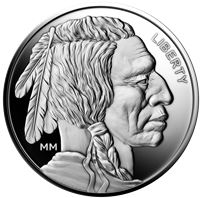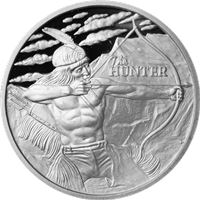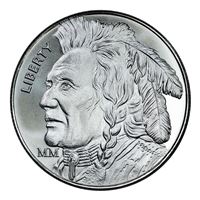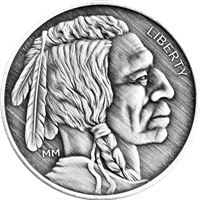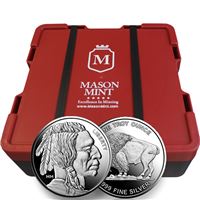Silver Buffalos
- Gold
- Silver
- Platinum
- Palladium
- 1 gram
- 2.5 gram
- 5 gram
- 10 gram
- 50 gram
- 100 gram
- 250 gram
- 1/20 oz
- 1/10 oz
- 1/5 oz
- 1/4 oz
- 1/2 oz
- 1 oz
- 2 oz
- 5 oz
- 10 oz
- 20 oz
- 50 oz
- 100 oz
- 1/2 kilo
- 1 kilo
- 5 kilo
- 10 kilo
- Silver
- Silver Rounds
-
Silver Buffalos
- All Silver Rounds
- Silver Art Rounds
Silver Buffalos
Gainesville Coins offers the best, non-government issued Silver Buffalo rounds. The .999 fine silver rounds are privately minted and emulate the design of the 1913 to 1938 buffalo nickel.
Buy Silver Buffalo Rounds Online
The Gainesville Coin Silver Buffalo round honors the design of the original Buffalo nickel. Instead of the date that might be found on the nickel, the round reads, “One Troy Ounce .999 Fine Silver.” This silver round is not legal tender, but is a great silver investment.
Buffalo Nickel History
The Buffalo Nickel, also known as the Indian Head Nickel or the Bison Nickel, was met with some controversy. Because of the coin’s 75% copper composition, some argued that it shouldn’t be called a nickel. rather, they argued that it should have been called a copper.
Similarly, the American colloquialism for bison, buffalo, was questioned in the Buffalo Nickel. Stuart Mosher, a prominent numismatist at the time, believed the coin should have been called the bison copper. Of course, Mosher’s name was never picked up, as the coin is still referred to as the Buffalo Nickel or the Indian Head Nickel.
The Buffalo Nickel was introduced in 1913, and was quickly a favorite among collectors. The reverse design originally used a rounded design for the ground beneath the buffalo’s hooves, but proved too difficult to strike. The ground was changed to a flat design later that year. The coin’s minting history is fraught with striking errors and eventually led to its replacement by the Jefferson nickel design after 1938.
Buffalo Nickel Design
The coin was designed by the prominent James Earle Fraser, who is most famous for his Buffalo nickel design and his End of the Trail sculpture. In 1911, the Mint began its search for a new nickel design. Interestingly, the Minnesota-born sculptor became the designer of the Buffalo nickel after he approached the Mint with several designs for a new nickel.
Fraser drew his inspiration for the obverse of the nickel from a conglomeration of three Native American models. While none of Fraser’s models are confirmed, it is rumored that Chief Iron Tail of the Oglala Lakota, Chief Two Moons of the Cheyenne, and Chief John Big Tree of the Seneca are his main models. Chief John Big Tree also claimed to be the model for Fraser’s End of the Trail sculpture.
Black Diamond, Fraser’s model for the American bison the obverse of the nickel is said to have resided in the Central Park Zoo. Fraser had difficulty sketching Black Diamond as the bison refused to turn to the side. Fraser’s profile of Black Diamond may never have come to fruition, but luckily, Fraser was finally able to attain a satisfactory profile.

